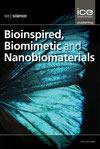仿生羟基磷灰石侵蚀下牛牙表面超微结构的变化
IF 0.6
4区 工程技术
Q4 ENGINEERING, BIOMEDICAL
引用次数: 0
摘要
牙釉质和牙本质容易受到食物来源中的酸的影响,从而导致牙齿腐蚀,这是一个影响数百万人的全球性问题。牙齿表面的羟基磷灰石颗粒(HAP)会影响酸侵蚀的效果。标准化的牛牙釉质和牙本质样品与人工唾液在体外循环脱矿-再矿化方案中使用高分辨率扫描电子显微镜来分析牙齿表面经历的结构变化,并评估基于hap的口腔护理凝胶在保护牙齿免受侵蚀攻击方面的潜力。利用聚焦离子束制备和透射电镜研究了HAP粒子与珐琅HAP晶体之间的界面。结果表明,磷酸对牙本质微管和牙釉质微晶的侵蚀作用较为严重,而人工唾液对牙本质微管的再矿化作用较为明显。hap凝胶在牙釉质和牙本质表面形成微观层。在酸暴露后,这一层在原生牙齿组织受到影响之前就被牺牲了,与对照组相比,导致脱矿程度明显降低。这表明,在口腔护理配方中使用颗粒HAP作为生物材料,可以使用简单有效的保护原理帮助保护牙釉质和牙本质表面免受侵蚀。本文章由计算机程序翻译,如有差异,请以英文原文为准。
Ultrastructural changes of bovine tooth surfaces under erosion in presence of biomimetic hydroxyapatite
Enamel and dentin are susceptible to acids from food sources leading to dental erosion, a global problem affecting millions of individuals. Particulate hydroxyapatite (HAP) on the tooth surface can influence the effects of acid attacks. Standardized bovine enamel and dentin samples with artificial saliva are used in an in vitro cyclic demineralization–remineralization protocol to analyze the structural changes experienced by tooth surfaces using high-resolution scanning electron microscopy and to evaluate the potential of a HAP-based oral care gel in the protection of teeth from erosive attacks. The interfaces between HAP particle and enamel HAP crystallites are investigated using focused ion beam preparation and transmission electron microscopy. The results show that erosion with phosphoric acid severely affects enamel crystallites and dentin tubules, while artificial saliva leads to remineralization effects. The HAP-gel forms a microscopic layer on both enamel and dentin surfaces. Upon acid exposure, this layer is sacrificed before the native tooth tissues are affected, leading to significantly lower degrees of demineralization compared to the controls. This demonstrates that the use of particulate HAP as a biomaterial in oral care formulations can help protect enamel and dentin surfaces from erosive attacks during meals using a simple and effective protection principle.
求助全文
通过发布文献求助,成功后即可免费获取论文全文。
去求助
来源期刊

Bioinspired Biomimetic and Nanobiomaterials
ENGINEERING, BIOMEDICAL-MATERIALS SCIENCE, BIOMATERIALS
CiteScore
2.20
自引率
0.00%
发文量
12
期刊介绍:
Bioinspired, biomimetic and nanobiomaterials are emerging as the most promising area of research within the area of biological materials science and engineering. The technological significance of this area is immense for applications as diverse as tissue engineering and drug delivery biosystems to biomimicked sensors and optical devices.
Bioinspired, Biomimetic and Nanobiomaterials provides a unique scholarly forum for discussion and reporting of structure sensitive functional properties of nature inspired materials.
 求助内容:
求助内容: 应助结果提醒方式:
应助结果提醒方式:


